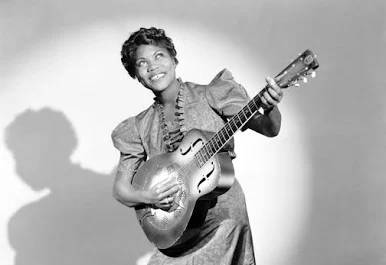Here’s a comprehensive overview:
https://www.youtube.com/watch?v=-88l-M0KgkI
Early Life
- Born Rosetta Nubin on 20 March 1915, in Cotton Plant, Arkansas.
- Raised by her mother, Katie Bell Nubin, an evangelist and mandolin player for the Church of God in Christ (COGIC).
- Began playing guitar and singing gospel at age 4, performing with her mother in evangelist troupes across the South.
- Moved to Chicago in the 1920s, where she absorbed jazz and blues influences while continuing gospel performances.
Career Milestones
- 1938: Signed with Decca Records and recorded hits like “Rock Me” and “This Train”, blending gospel lyrics with jazz and swing rhythms.
- Performed at Harlem’s Cotton Club and Carnegie Hall’s From Spirituals to Swing concert, introducing gospel to mainstream audiences.
- Collaborated with jazz greats like Cab Calloway and swing bandleader Lucky Millinder. These collaborations not only expanded her musical horizons but also introduced her to new audiences, showcasing her versatility and influence in the music industry.
- Her 1945 song “Strange Things Happening Every Day” became the first gospel record to cross over to the R&B charts, a precursor to rock & roll.
Musical Innovations
- Among the first popular artists to use the electric guitar with distortion, influencing the sound of rock.
- Guitar style featured single-note riffs, bending, and phrasing, rare for women in the 1930s–40s.
- Blended gospel, blues, jazz, and swing, creating a genre-defying sound that paved the way for rock & roll.
Influence
- Her influence extended far beyond her own era, directly inspiring legends such as Chuck Berry, Little Richard, Elvis Presley, Johnny Cash, Tina Turner, and British blues icons Eric Clapton and Keith Richards. Their acknowledgment of her Impact on their own musical journeys is a testament to her enduring influence.
- Chuck Berry famously said his career was “one long Rosetta Tharpe impression.” ,
Later Years & Legacy
- Continued touring internationally through the 1950s–60s, including Europe with Muddy Waters.
- Despite suffering a stroke in 1970, which led to health complications, she continued to perform until her passing on 9 October 1973, in Philadelphia. Her unwavering dedication to her craft and her ability to overcome adversity are a testament to her strength and resilience.
- Posthumous honors:
- Rock & Roll Hall of Fame (2018).
- U.S. Postal Service commemorative stamp (1998).
- Subject of PBS documentary “Sister Rosetta Tharpe: The Godmother of Rock & Roll” (2013).
She blended gospel fervor with elements of blues and early rock.
Here are the key aspects of her style:
1. Open Tunings and Down-Tuning
- She favored Vestapol tuning (Open E), which is unusual for non-slide players. This allowed her to use open strings creatively to ring chords and play melodic runs.
- Often tuned down a tone or even a minor third, giving her guitar a deeper, fuller sound and making bends easier.
2. Thumb Pick and Driving Rhythms
- Used a thumb pick for strong, percussive strumming and bass lines, creating a rhythmic foundation that felt both gospel and swing-inspired.
- Her strumming was energetic and syncopated, often mimicking the feel of a whole rhythm section.
3. Double-Stops and Chromatic Runs.
She frequently employed double-stops (two notes played together) for harmonized riffs and fills.
- Incorporated chromaticism—sliding between notes outside the scale—to add tension and excitement.
- Combined with fast triplet runs, giving her solos a fiery, jazz-like quality.
4. Blues and Gospel Vocabulary
- Mixed pentatonic blues licks with diatonic gospel phrases, creating a unique hybrid sound.
- Avoided heavy string bending (common in later blues-rock), instead using slides and half-step curls for expression.
5. Harmonic Awareness
- Her solos often outlined chord changes, showing a jazz influence.
- Integrated chord-based motifs into lead lines, making her improvisation sound structured yet soulful.
6. Early Use of Distortion
- One of the first guitarists—especially in gospel—to use amplified distortion, giving her tone grit and sustain that prefigured rock guitar.
